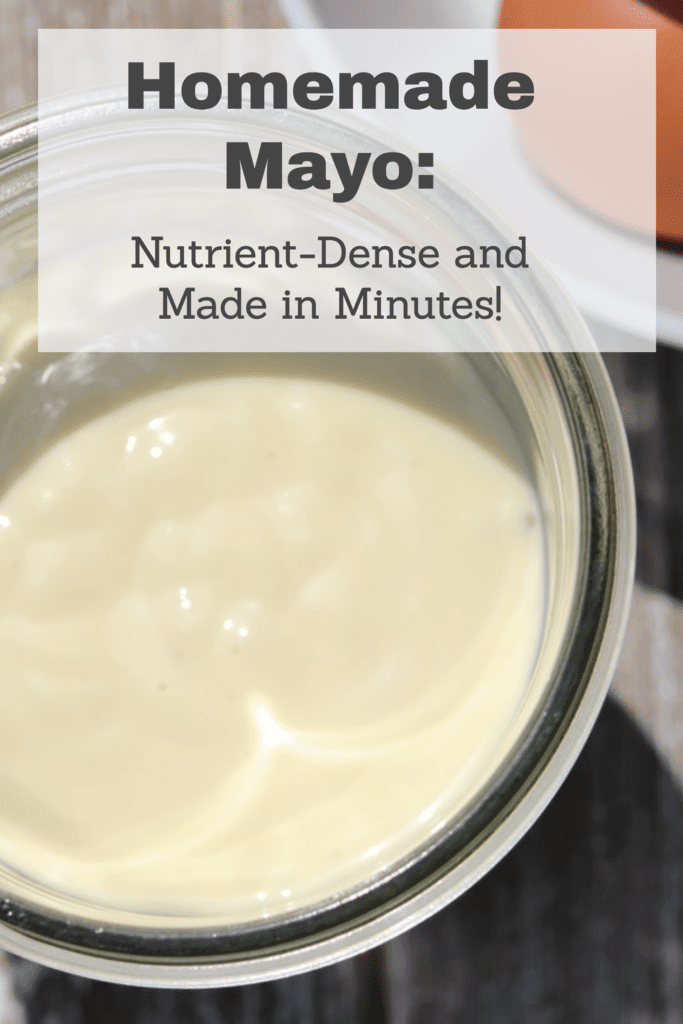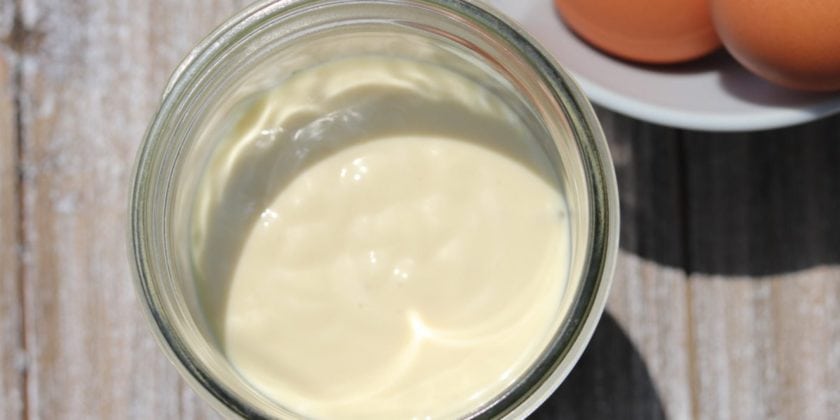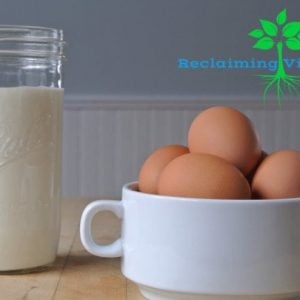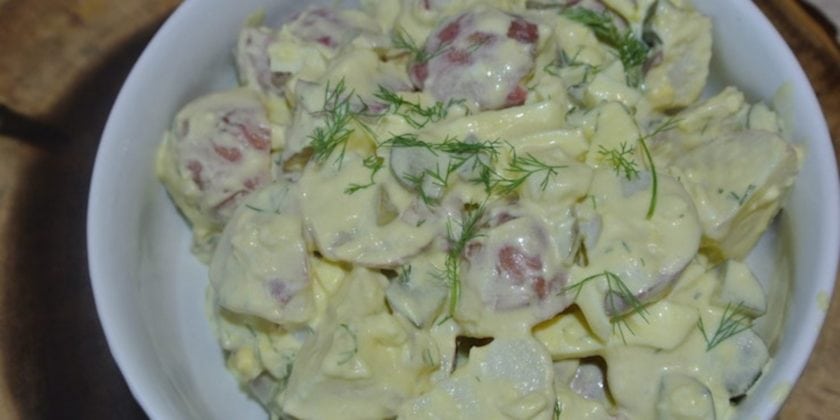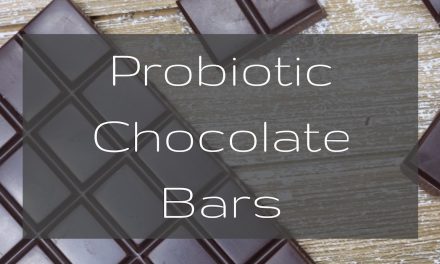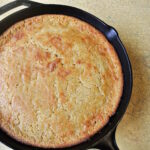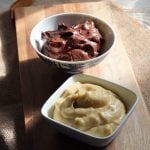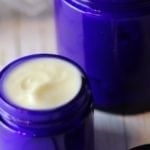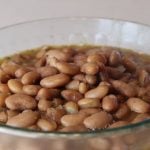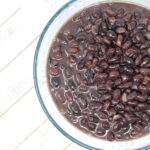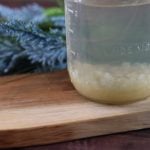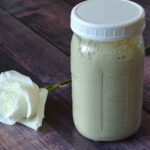Making homemade mayo requires only a few ingredients and takes just a couple of minutes! The difference between mayo bought in the store and mayo made at home is astounding, both the taste and the nutritional profile. It makes such a difference when you can control the quality of ingredients in your food!
What’s in store-bought mayo?
Let me start by breaking down what is in that typical bottle of store-bought mayo. First, if it actually contains eggs (some don’t), they are certainly not pastured or even organic. Why does this matter? The difference is nature’s perfect food versus a toxic bomb for your body. Please indulge me while I illustrate my point.
Organic Pastured Eggs vs. conventional eggs:
A Pastured organic egg
An organic pastured egg comes from hens able to run around and forage for protein-rich bugs, eat vitamin-rich grasses and soak up real live sunshine (aka vitamin D). If their feed needs to be supplemented, it is supplemented with organic grains that have not been genetically modified nor soaked in pesticides. In short, these are happy birds.
A conventional egg
A conventional egg comes from factory-farmed chickens who are kept in cages without sunlight (aka vitamin D). They are fed conventional grains and often soy, both of which are almost always GMO. Often the cages are stacked on top of one another and they poop all over each other. Close quarters means a lot of sickness, so they are given antibiotics to keep them “healthy”. Even “cage-free” chickens are only required to have a few feet per bird and are often not able to forage. They may not even be in the sun ever. Some cage-free farms have their birds inside on the floors of large barns.
More store-bought mayo ingredients
Okay, I’m done with my tirade on eggs. Whew! If that wasn’t enough to convince you, let’s get back to the rest of the ingredients. The typical jar contains rancid vegetable oils (they don’t smell or taste rancid because of extensive processing) It also contains preservatives. Many contain GMO cornstarch. (Almost all cornstarch is GMO, as is almost all non-organic corn and other corn products like corn syrup.) Most store-bought jars also contain artificial food coloring. Here is a high-quality, organic mayo if you feel like making mayo, however simple it is, just isn’t for you.
What’s in homemade mayo?
Homemade mayonnaise has only a few ingredients.
- Eggs, preferably pastured, of course.
- Oil (choose a high quality oil that is minimally processed for the most nutrients. I love avocado oil because it is loaded with healthy fats, vitamins, and minerals, and it has a light taste.
- Salt (choose a high quality sea salt for the most nutrients)
- An acidic liquid such as lemon juice, apple cider vinegar (use raw), or Kombucha
- water (this helps it emulsify into that thick creamy texture. I have to give credit to Jenny from Nourished Kitchen for the tip to add a tablespoon of water! My mayo texture was hit or miss until I learned this tip from her blog! (It’s an amazing blog, by the way.)
Ready to make your own mayo?
Not only are there few ingredients, but it will truly only take you a few minutes! I make the lacto-fermented version of this mayo about once every other week. This version keeps longer because it is fermented, and it has all the benefits of a fermented condiment, such as probiotics and more bio-available vitamins and minerals. If you don’t have any Kombucha, don’t worry. You can make the regular version. You might want to cut the recipe in half though as it will only keep for a week or so.
You will need:
- 4 pastured egg yolks
- 1 3/4 cup oil (I prefer avocado oil for it’s light taste and amazing nutrient content)
- 1 tablespoon of water
- 1/4 cup lemon juice, ACV (apple cider vinegar) (or plain Kombucha for lacto-fermented version)
- 3/4 teaspoon sea salt
- Optional: 1/2 teaspoon mustard powder
Directions for Food Processor or Blender:
- Put yolks, water, salt, and lemon juice (or ACV) into a food processor (or blender).
- Process until well mixed.
- Drizzle the oil in slowly while the food processor is running.
- Once the oil is added, continue processing until the mayo thickens. About 4 minutes.
- Transfer to a clean glass jar and use within one week unless you are making the lacto-fermented version.
Directions for Stick Blender:
- Add all ingredients to a quart mason jar.
- Place the stick blender at the bottom of the jar and blend.
- Once the egg yolks are mixed, move the stick blender up and down until you get the desired consistency.
Homemade mayo (with a fermented option)
Ingredients
- 4 pastured egg yolks
- 1 3/4 cup oil I prefer avocado oil for it's light taste and amazing nutrient content
- 1 tablespoon of water
- 1/4 cup lemon juice ACV (apple cider vinegar) (or plain Kombucha for lacto-fermented version)
- 3/4 teaspoon sea salt
- Optional: 1/2 teaspoon mustard powder
Instructions
- Put yolks, water, salt, and lemon juice (or ACV) into a food processor (or blender). Process until well mixed.
- Drizzle the oil in slowly while the food processor is running. Once the oil is added, continue processing until the mayo thickens. About 4 minutes.
- Transfer to a clean glass jar and use within one week unless you are making the lacto-fermented version.
Notes
To make a thinner mayo for a dip, replace one egg yolk with a whole egg.
Need some ideas for mayonnaise uses besides as a sandwich spread?
Make Probiotic Tartar Sauce, Magnesium-rich ranch, and add it to Probiotic Potato salad. Add crushed garlic or lemon and dill for tasty a aioli.
Do you make your own mayo? Will you give it a try?
